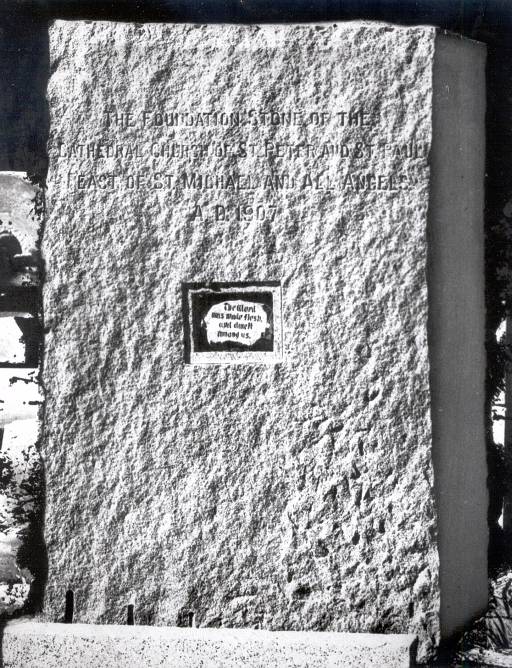Tuesday, December 20, 2011 3:11 PM

 In 2007, Washington National Cathedral held a year-long centennial celebration of its first stone being laid. That first stone is named the Foundation Stone and it consists of a large slab of American granite with a smaller stone from Bethlehem, in the Holy Land, imbedded in its surface. In addition to several inscriptions on its surface, the Foundation Stone provides structural support for the altar and reredos in Bethlehem Chapel, which in turn supports the Jerusalem Altar on the Cathedral’s main level. In 1907, tens of thousands of people attended the service when the Foundation Stone was set, including President Theodore Roosevelt and other honored dignitaries. However, today no one can see the Foundation Stone because it is encased within the surrounding foundation walls of the Cathedral’s subcrypt.
In 2007, Washington National Cathedral held a year-long centennial celebration of its first stone being laid. That first stone is named the Foundation Stone and it consists of a large slab of American granite with a smaller stone from Bethlehem, in the Holy Land, imbedded in its surface. In addition to several inscriptions on its surface, the Foundation Stone provides structural support for the altar and reredos in Bethlehem Chapel, which in turn supports the Jerusalem Altar on the Cathedral’s main level. In 1907, tens of thousands of people attended the service when the Foundation Stone was set, including President Theodore Roosevelt and other honored dignitaries. However, today no one can see the Foundation Stone because it is encased within the surrounding foundation walls of the Cathedral’s subcrypt.
With such attention lavished on the Foundation Stone in 1907, it seems odd to make it inaccessible for future generations to appreciate. Since the Cathedral planned to celebrate the centennial of the Stone’s creation, I thought it appropriate and necessary to research the Stone’s history, identify the people involved in its development, learn the reasons behind its design, the meaning of its symbolism and celebrated installation, and discover the explanation for its inaccessibility, so that others might find a deeper appreciation of its significance.
My research took me to a number of primary sources: the Cathedral’s construction document archives, the diary of the Bishop of Washington at the time, The Foundation Stone Book that documents the installation services, an array of historic photos and other newspapers and periodicals from the early twentieth century. Secondary sources included: Cathedral Age, a Cathedral-produced periodical with references to the Foundation Stone’s fiftieth anniversary, numerous books on the history of the Cathedral’s construction by various authors, and other Cathedral-related publications.
Based on the historical information gathered from these sources, I wrote a paper entitled, “The Foundation Stone: Creating Sacred Space at Washington National Cathedral,” and presented it at “Building Spiritual Washington," the Seventh Biennial Symposium of the Latrobe Chapter of the Society of Architectural Historians in Washington, DC. To support my text, I provided numerous illustrations in a PowerPoint presentation. Following that event, I reshaped the text to become a chapter entitled, “Hidden Eternity: Marking A Sacred Space,” contained within Living Stones: Washington National Cathedral at 100, a book published by the Cathedral during the centennial year. I further condensed the paper into training materials for docents to use with visitors coming to the Cathedral during the year. Throughout the course of the centennial year, I shared my historical research and PowerPoint presentation to numerous gatherings of special tour groups, Governance and visiting dignitaries. Finally, the Cathedral made a video of me explaining the history of the Foundation Stone and offering its story as a meditation to viewers on the Cathedral’s website.
The Foundation Stone, a seemingly simple, yet incredibly symbolic element in the life of Cathedral, provides insights on the religious beliefs and practices of the early builders of the National Cathedral. The variable forms of sharing this historic information helped many people in the present day better understand their forebears of more than a hundred years ago.
[Read the rest of this article...]